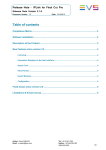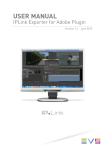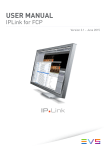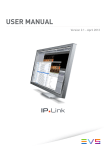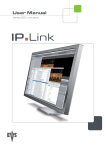Download Patton electronic 2620 User's Manual
Transcript
IPLink™ Model 2603 & 2620 WAN Access Router Quick Start Guide Document Number: 03323U7-001 Rev. B Part Number: 07M2620-QS Revised: October 4, 2005 Sales Office: +1 (301) 975-1000 Technical Support: +1 (301) 975-1007 E-mail: [email protected] WWW: www.patton.com • The IPLink 2603/2620 contains no user serviceable parts. The equipment shall be returned to Patton Electronics for repairs, or repaired by qualified service personnel. WARNING • An approved external power supply that incorporates a disconnect device shall be used and positioned within easy reach of the operator. • For AC powered units, the power cable used to connect the power supply shall meet all applicable standards for the country in which it is to be installed, and be connected to a wall outlet which has earth ground. • Hazardous network voltages are present in WAN ports regardless of whether power to the unit is ON or OFF. To avoid electric shock, use caution when near WAN ports. When detaching the cables, detach the end away from the 2603/2620 first. • Do not work on the system or connect or disconnect cables during periods of lightning activity. 1.0 Power up the router The interconnecting cables shall be acceptable for external use and shall be rated for the proper application with respect to voltage, current, anticipated temperature, flammability, and mechanical serviceability. CAUTION Your router comes with one of the following power supply options: • External AC adaptor with included power cord • Internal AC power supply • Internal DC power supply—no power accessories are included 1.1 Models with external AC adaptor 1. Connect female plug of the AC power cord to the AC adaptor provided. 2. Connect the barrel-type connector of the AC adaptor to the barrel-type Power jack on the IPLink router. 3. Insert the male plug of the AC power cord into an AC power outlet (100–240 VAC). 1.2 Models with internal AC power supply 1. Insert the female end of the AC power cord into the internal power supply connector. 2. Connect the male end of the power cord into an AC power outlet (100–240 VAC). 2 IPLink 2603 & 2620 Quick Start Guide 1.3 Models with internal DC power supply 1. 2. 3. 4. Strip insulation 1/4-inch from the electrical wires that will connect the DC power source to the IPLink. Connect the ground terminal from the power source to the ground terminal on the IPLink. Connect the negative (-) terminal from the power source with to the negative (-) terminal on the IPLink. Connect the positive (+) terminal from the power source with to the positive (+) terminal on the IPLink. 1.4 Power-up indication The Power LED blinks as the IPLink is powering up. When the Power LED stops blinking and remains lit, the IPLink is ready for you to configure. 2.0 Configure the IP address The IPLink is shipped with a factory-configured IP address assigned to the Ethernet LAN port (green outline). The address is 192.168.200.10/24. In most cases, you must change the address to be on the same subnet as your PC, as described in the procedures below. If you are not sure which IP address to use for your installation, contact your network administrator. 2.1 Connecting a PC and logging in 1. Using the included combination RS232/Ethernet cable and DB9-RJ45 adapter, connect a PC’s serial port to the IPLink’s Console port (see figure 1). PC with terminal emulator ay tew Ga uter ink Ro ipL ss ce 3 60 Ac l 2 AN de ed W Moh Spe le so n Co in k 1 0 0 T M x R x Hig L L in k F ra m T e D R D e r o w P Serial port et ern Eth AN W Connect to Console port Figure 1. Connecting IPLink to the PC’s serial port 2. Start a HyperTerminal session on the PC using the settings: 9600 bps, 8 data bits, 1 stop bit, no parity, no flow control 3. Log in to the IPLink using the factory-default login and password: Login: superuser Password: superuser Login successful IPLink 2603 & 2620 Quick Start Guide 3 2.2 Modifying the IP address 1. Display current IP interface settings for the IPLink Ethernet LAN port. → ip list interfaces <enter> IP Interfaces: ID | Name | IP Address | DHCP | Transport ---|------|----------------|----------|-------------1 | ip1 | 192.168.200.10 | disabled | <eth1> ---------------------------------------------------- 2. Modify the IP address for the LAN port according to your network requirements. → ip set interface ip1 ipaddress 10.10.10.5 255.255.255.0 Note The above IP address (10.10.10.5/24) is only an example. You must choose an IP address on the same subnet as your PC. 3. Verify the new address is correct and save it in system boot memory. → → → ip list interfaces <enter> system config save <enter> Now you can connect the IPLink to your local IP network and complete the remaining configuration from your PC using a standard web browser. 3.0 Connect to the local IP network Connect the IPLink’s (green) Ethernet port to the same Ethernet segment as your PC (see figure 2). Note The Model 2620 does not have an MDI-X switch, so you must use a cable wired straight-through to connect the Model 2620’s Ethernet port to the IP network. If you have a Model 2603, press the MDI-X switch until the Ethernet Link LED turns on. Connect to Ethernet port 10 /100 PC Pow er Cro RX ss ov Eth er er ne t MD I-X TX W AN Ethernet port MDI-X switch Figure 2. Connecting the IPLink to the local IP network (Model 2603/K shown) 4 IPLink 2603 & 2620 Quick Start Guide You can check the network connection with the ping command. For example, you would ping 10.10.10.5 from your PC. 4.0 Log onto the web management interface You will now access the web management Graphical User Interface (GUI) to configure the IPLink using a standard web browser (such as Internet Explorer or Netscape browser). 1. At your PC, open a web browser and enter the IP address you assigned to the IPLink’s Ethernet LAN port in step 2 of section 2.2 “Modifying the IP address” on page 4. 2. Log in to the web management home page using the username superuser and the password superuser. Figure 3. IPLink web management home page 3. Now you can use the IPLink’s web management pages to complete your configuration (see section 6.0 “Complete the installation” on page 6). 5.0 Connect the WAN port The IPLink 2603/T, 2603/K, and 2620 come with a T1/E1 WAN interface (presented on an RJ-48C connector with selectable line impedances of 100-ohms for T1 and 120-ohms for E1 lines). The Model 2603 has one RJ48C connector and the 2620 has two. The Model 2603/K and 2620/KK also come with dual BNC connectors for alternate connection to unbalanced 75-ohm E1 lines. To connect the WAN port on a Model 2620 or Model 2603/T, or if you plan to use the RJ-48C port on a 2603/K, refer to section “Connecting to the RJ-48C WAN port”. Otherwise, refer to section “Connecting to the unbalanced 75-ohm TX and RX WAN ports (Model 2603/K and 2620/KK only)” to install cables onto the BNC connectors on the 2603/K and 2620/KK models. IPLink 2603 & 2620 Quick Start Guide 5 Connecting to the RJ-48C WAN port 1. Obtain a twisted-pair cable with an RJ-48C plug connector at each end. 2. Plug one end of the cable into the RJ-48C socket (labeled WAN) on the IPLink Router. 3. Plug the other end of the cable into the T1/E1 device. 4. Repeat steps 1 through 3 to install the remaining WAN cables on a Model 2620 Connecting to the unbalanced 75-ohm TX and RX WAN ports (Model 2603/K and 2620/KK only) 1. Obtain a coaxial cable with a BNC connector at each end. 2. Plug one end of the cable into the transmit socket (labeled TX) on the IPLink Router. Plug the other end of the cable into the receive port of the E1 device. 3. Plug one end of the cable into the receive socket (labeled RX) on the IPLink Router. Plug the other end of the cable into the transmit port of the E1 device. 6.0 Complete the installation To finish configuring your IPLink, and for detailed information about installing, configuring, operating, and troubleshooting, refer to the Models 2603, 2621, and 2635 IPLink Series High Speed Routers User Guide and application notes, available on the enclosed Patton CD-ROM or at www.patton.com. A.0 Customer and Technical Support Toll-Free VoIP support: call sip:[email protected] with a VoIP SIP phone Online support: www.patton.com E-mail support: [email protected]—answered within 1 business day Telephone support: • Standard: +1 (301) 975-1007 (USA), Monday–Friday: 8:00 am to 5:00 pm EST (1300 to 2200 UTC/GMT) • Alternate: +41 (0)31 985 25 55 (Switzerland), Monday–Friday: 8:00 am to 5:00 pm CET (0900 to 1800 UTC/GMT) Fax: +1 (253) 663-5693 (USA) or +41 (0)31 985 25 26 (Switzerland) 6 IPLink 2603 & 2620 Quick Start Guide B.0 Compliance Information B.1 Radio and TV Interference (FCC Part 15) This equipment generates and uses radio frequency energy, and if not installed and used properly—that is, in strict accordance with the manufacturer's instructions—may cause interference to radio and television reception. This equipment has been tested and found to comply with the limits for a Class A computing device in accordance with the specifications in Subpart B of Part 15 of FCC rules, which are designed to provide reasonable protection from such interference in a commercial installation. However, there is no guarantee that interference will not occur in a particular installation. If the equipment causes interference to radio or television reception, which can be determined by disconnecting the cables, try to correct the interference by one or more of the following measures: moving the computing equipment away from the receiver, re-orienting the receiving antenna, and/or plugging the receiving equipment into a different AC outlet (such that the computing equipment and receiver are on different branches). B.2 EC Declaration of Conformity Product Description: IPLink 2603, 2620 We certify that the apparatus identified above conforms to the requirements of Council Directive 1999/5/EC on the approximation of the laws of the member states relating to Radio and Telecommunication Terminal Equipment and the mutual recognition of their conformity. The safety advises in the documentation accompanying the products shall be obeyed. The conformity to the above directive is indicated by the CE sign on the device. The signed Declaration of Conformity can be downloaded from www.patton.com/certifications/. B.3 FCC Part 68 (ACTA) Statement This equipment complies with Part 68 of FCC rules and the requirements adopted by ACTA. On the bottom side of this equipment is a label that contains—among other information—a product identifier in the format US: AAAEQ##TXXXX. If requested, this number must be provided to the telephone company. The method used to connect this equipment to the premises wiring and telephone network must comply with the applicable FCC Part 68 rules and requirements adopted by the ACTA. If this equipment causes harm to the telephone network, the telephone company will notify you in advance that temporary discontinuance of service may be required. But if advance notice isn’t practical, the telephone company will notify the customer as soon as possible. Also, you will be advised of your right to file a complaint with the FCC if you believe it is necessary. The telephone company may make changes in its facilities, equipment, operations or procedures that could affect the operation of the equipment. If this happens, the telephone company will provide advance notice in order for you to make necessary modifications to maintain uninterrupted service. If trouble is experienced with this equipment, for repair or warranty information, please contact our company. If the equipment is causing harm to the telephone network, the telephone company may request that you disconnect the equipment until the problem is resolved. IPLink 2603 & 2620 Quick Start Guide 7 Connection to party line service is subject to state tariffs. Contact the state public utility commission, public service commission or corporation commission for information. B.4 Industry Canada Notice This equipment meets the applicable Industry Canada Terminal Equipment Technical Specifications. This is confirmed by the registration number. The abbreviation, IC, before the registration number signifies that registration was performed based on a Declaration of Conformity indicating that Industry Canada technical specifications were met. It does not imply that Industry Canada approved the equipment. This Declaration of Conformity means that the equipment meets certain telecommunications network protective, operational and safety requirements. The Department does not guarantee the equipment will operate to the user’s satisfaction. Before installing this equipment, users should ensure that it is permissible to be connected to the facilities of the local telecommunications company. The equipment must also be installed using an acceptable method of connection. In some cases, the company’s inside wiring associated with a single line individual service may be extended by means of a certified connector assembly (telephone extension cord). The customer should be aware that compliance with the above condition may not prevent degradation of service in some situations. Repairs to some certified equipment should be made by an authorized maintenance facility designated by the supplier. Any repairs or alterations made by the user to this equipment, or equipment malfunctions, may give the telecommunications company cause to request the user to disconnect the equipment. Users should ensure for their own protection that the ground connections of the power utility, telephone lines and internal metallic water pipe system, are connected together. This protection may be particularly important in rural areas. Copyright statement Copyright © 2005, Patton Electronics Company. All rights reserved. The information in this document is subject to change without notice. Patton Electronics assumes no liability for errors that may appear in this document. Trademarks statement The term IPLink is a trademark of Patton Electronics Company. All other trademarks presented in this document are the property of their respective owners. Warranty, Trademark, & Compliance Information For warranty, trademark and compliance information, refer to the Models 2603, 2621, and 2635 IPLink Series High Speed Routers User Guide located on the CD-ROM that came with your router or available online at www.patton.com. In accordance with the requirements of council directive 2002/96/EC on Waste of Electrical and Electronic Equipment (WEEE), ensure that at end-of-life you separate this product from other waste and scrap and deliver to the WEEE collection system in your country for recycling. 8 IPLink 2603 & 2620 Quick Start Guide








